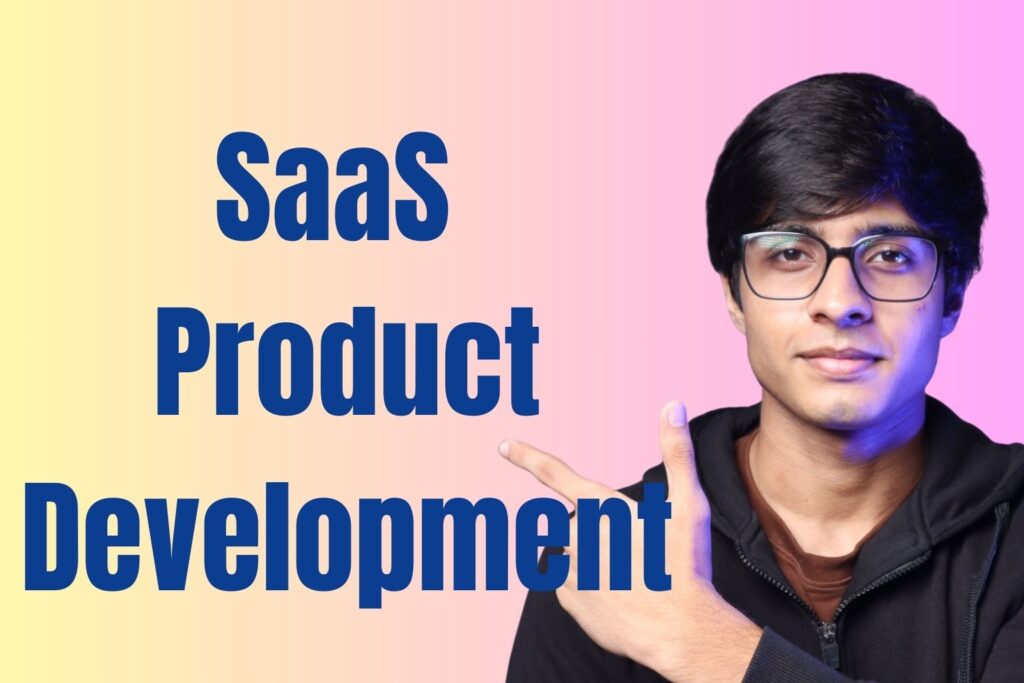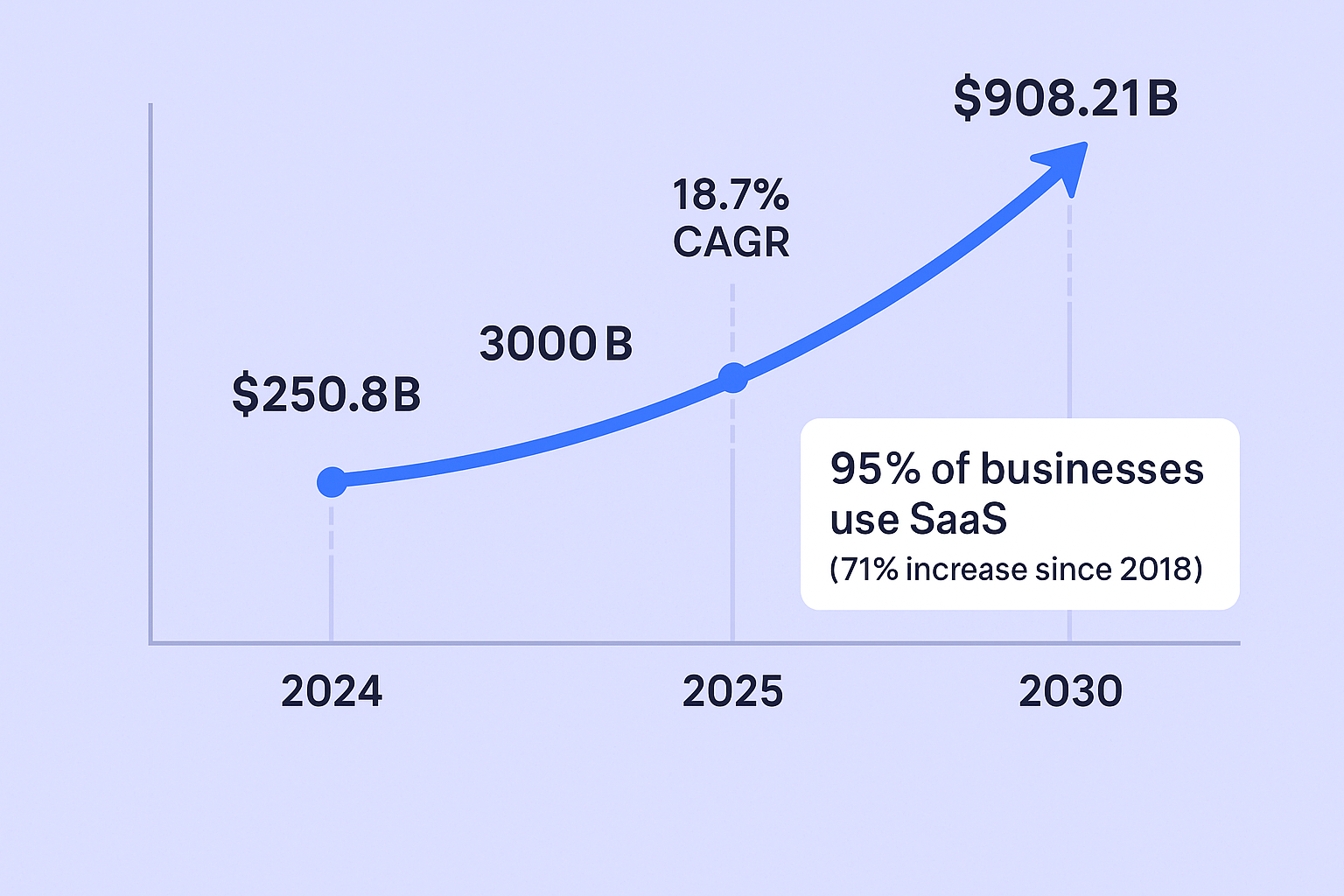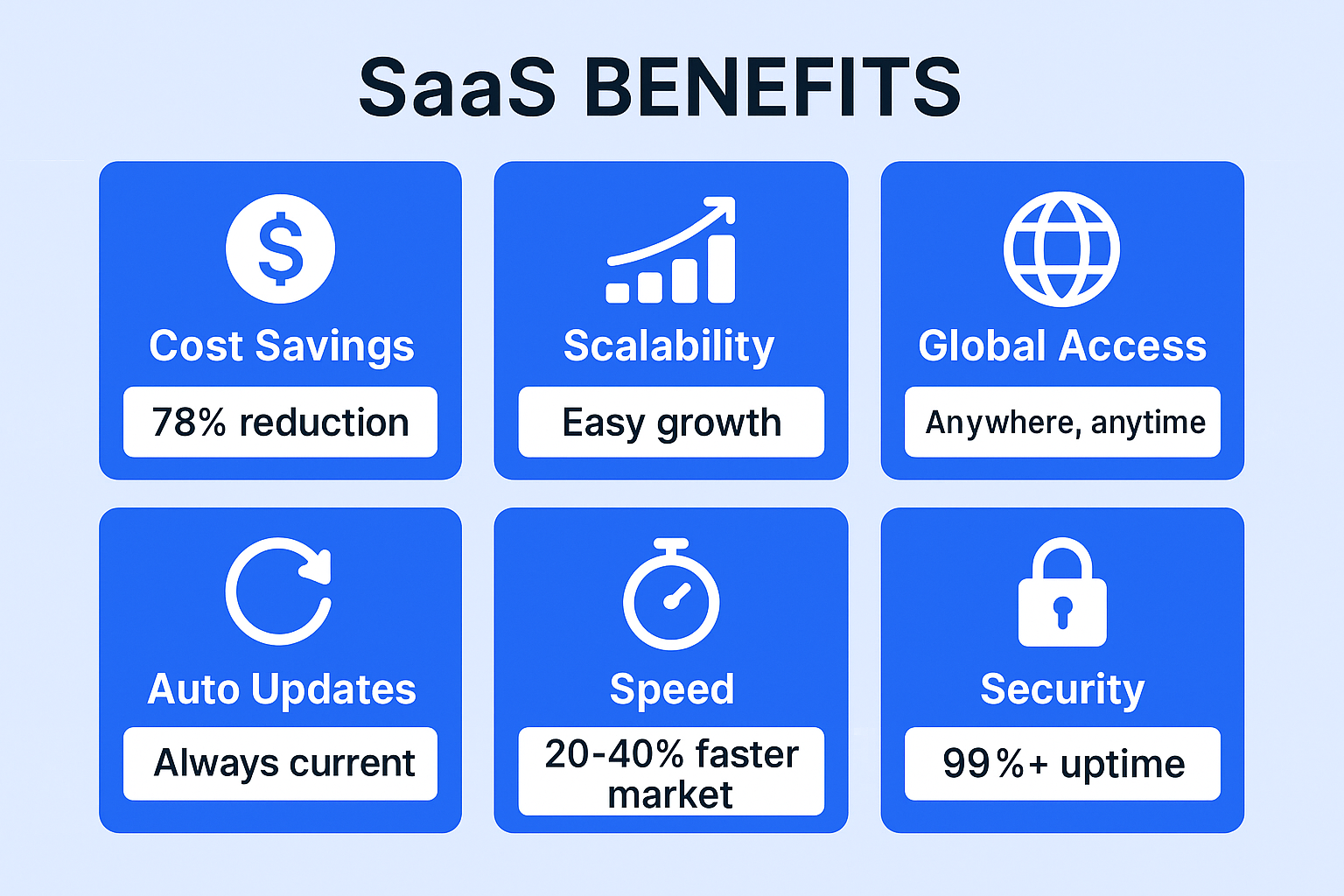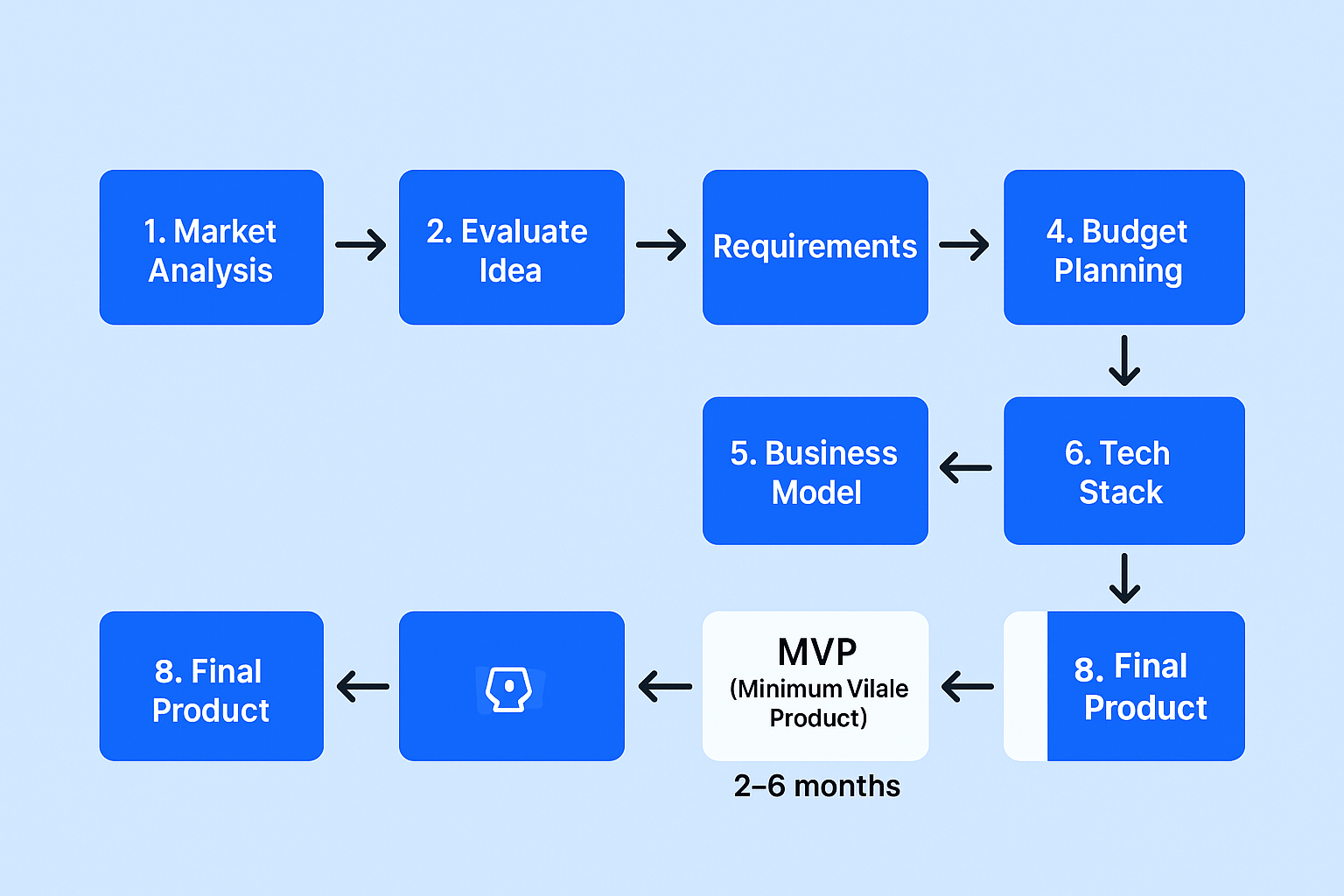- blog
- Sales Development
- SaaS Product Development Guide: Build & Launch Your SaaS 2025

Table of Contents
The SaaS market is exploding. With projections showing it will reach $300 billion in 2025, this isn’t just a trend—it’s a massive opportunity. For Business Development Representatives (BDRs) and Account Executives (AEs), understanding saas product development gives you a serious edge when engaging prospects.
When you know how SaaS products are built, you can anticipate your prospect’s pain points, handle objections confidently, and spot new opportunities faster. This guide walks you through everything—from market analysis to MVP creation to choosing the right tech stack. By the end, you’ll understand the complete saas product development process and never need to Google another article about it.
This guide walks you through everything—from market analysis to MVP creation to choosing the right tech stack. By the end, you’ll understand the complete saas product development process and never need to Google another article about it.
Understanding SaaS Applications
SaaS (Software as a Service) is a cloud-based software delivery model where users access applications through the internet, typically via a web browser. Think of it like Netflix for software—you stream it on demand without owning physical copies.
The key difference? The cloud service provider handles everything: servers, security, maintenance, and updates. Your prospects don’t need to worry about IT infrastructure headaches.
Here’s what makes SaaS applications special:
Scalability: These applications grow with your business. Need more users? More storage? More features? Just adjust your subscription level. Perfect for rapidly growing companies.
Cost-Effectiveness: No massive upfront investments in hardware or software licenses. You pay for what you use, when you use it.
Automatic Updates: The provider rolls out new features and security patches automatically. Your prospects always get the latest version without lifting a finger.
Multitenancy: One software instance serves multiple customers simultaneously, keeping costs down for everyone.
Accessibility: Access from any internet-connected device, anywhere in the world. Perfect for today’s remote and hybrid workforces.
This subscription model fundamentally changes how software companies think about revenue. Instead of one-time sales, success depends on continuous value delivery and long-term customer retention. For sales professionals, this means your conversations should focus on ongoing value and impact on recurring revenue.
Benefits of SaaS Products for Businesses
 Businesses are flocking to saas product solutions for compelling reasons that directly address modern operational challenges:
Businesses are flocking to saas product solutions for compelling reasons that directly address modern operational challenges:
Cost Savings & Efficiency: 78% of businesses using SaaS significantly reduced their maintenance and infrastructure costs. No more expensive hardware, software licenses, or ongoing IT maintenance. This freed-up budget can fuel innovation and growth.
Scalability & Flexibility: SaaS products are designed for easy scaling. Whether you’re adding users, features, or storage, everything adjusts seamlessly without performance hits.
Global Accessibility & Collaboration: Team members can work from any device with internet access. This is crucial for today’s distributed workforce.
Automatic Updates & Enhanced Security: Providers handle all software updates and security patches. Many SaaS vendors promise 99% or 99.9% uptime and invest heavily in cybersecurity protocols.
Faster Time to Market: Here’s a game-changer: companies get to market 20% to 40% faster by adopting cloud platforms. This speed advantage is critical in competitive industries.
Real-time Data & Analytics: Built-in analytics provide valuable insights into user behavior and performance, enabling data-driven decisions.
🎯 Target SaaS Decision Makers
LinkedIn outbound reaches 65M+ executives building and buying SaaS solutions
Here’s a quick summary of key SaaS benefits:
Benefit | Description | Impact |
Reduced Costs | Eliminates upfront hardware/software investments | 78% cost reduction in maintenance |
Scalability | Easily adjusts to growing needs | Perfect for rapidly growing businesses |
Global Access | Access from anywhere with internet | Supports remote and mobile workforces |
Auto Updates | Providers handle all updates and patches | Always current without user intervention |
Speed | Accelerates deployment of new capabilities | 20-40% faster time to market |
Security | Robust cybersecurity and disaster recovery | Many promise 99%+ uptime |
Top Reasons to Develop SaaS Products
The decision to pursue saas product development is driven by compelling market dynamics and significant business advantages:
Explosive Market Growth: The SaaS market was valued at $250.8 billion in 2024 and is projected to hit $300 billion in 2025. Looking ahead, it’s expected to reach $908.21 billion by 2030, growing at a 18.7% CAGR.
This growth is fueled by increasing demand for cloud-native applications and remote work solutions. By the end of 2023, 95% of businesses had implemented SaaS technologies—a 71% increase since 2018.
Predictable Recurring Revenue: The subscription model generates predictable, recurring income streams. Annual subscriptions are the most popular billing period, with an average contract length of 1.3 years. This stable revenue provides crucial financial predictability for long-term planning.
Global Reach: Developing a saas product inherently allows global customer reach. Since applications are accessed via the internet, geographical barriers disappear, expanding your potential market exponentially.
Innovation Hub: SaaS platforms increasingly enable cutting-edge technologies like AI and Machine Learning. 45% of SaaS companies consider AI accessibility a key factor in driving adoption within their products.
Competitive Advantage: Cloud-based solutions with flexible pricing and convenient access provide significant competitive edges in crowded markets.
💼 Connect During MVP Stage
Our LinkedIn campaigns identify prospects actively developing and evaluating SaaS tools
However, there’s a challenge beneath this growth. The “Rule of 40” (where revenue growth rate plus EBITDA margin should exceed 40%) reveals that only 11% of SaaS companies met this benchmark in 2024. This highlights that achieving sustainable profitability requires highly efficient tools and strategies.
The Process of SaaS Product Development
Understanding the saas product development process gives you insight into your prospect’s journey, challenges, and needs. Here’s how it works:
Conduct Market Analysis
The foundation of any product development journey starts with thorough market research. This involves deep dives into market share, size, consumer trends, and customer expectations.
The goal? Identify core user challenges your saas product could solve and understand how competitors are tackling similar problems. This analysis uncovers market gaps and validates (or invalidates) your initial concept.
Pro tip: Many teams run “smoke tests” by creating simple landing pages for MVP ideas, driving traffic, and measuring conversion metrics. This approach directly parallels how sales teams validate interest through initial outreach campaigns.
Evaluate Your Idea
Next, rigorously evaluate your product concept. Confirm there’s genuine user need, ensure strong problem-solution fit, and clearly articulate differentiation from competitors.
One innovative validation method is “fake door tests”—presenting features in the UI as if they’re ready, then tracking user clicks to gauge demand. This lean approach resonates with efficient, low-cost testing strategies sales teams use daily.
Thorough ideation and market research significantly reduce the risk of building something nobody wants.
Collect Fundamental Requirements
With a validated idea, define features and functionalities alongside crucial considerations like privacy protection, security audits, customization options, and scalability.
Given increasing cyberattacks and data safety concerns, ensuring your saas product meets stringent security standards is vital. Security is a top concern for 66% of organizations using public cloud technology, making it a frequent objection point in sales conversations.
The challenge? Balancing customization options with scalability requires careful planning to maintain core architecture and performance.
Plan the Budget
Create a realistic budget covering all anticipated costs: design, coding, business analysis, customer support, maintenance, and marketing efforts.
A clear financial blueprint helps avoid unforeseen expenses and delays that could require additional funding mid-development. The explicit inclusion of marketing costs presents opportunities for solutions like cold email addresses within the overall financial plan.
Finalize Business Model
Select the right pricing strategy that aligns with your product concept, target audience, and revenue objectives. Common models include:
Model | Description |
Freemium | Basic version free, advanced features paid |
Flat Rate | Single fixed price for all features |
Per User | Pricing based on number of users/seats |
Per Feature | Cost varies by specific features accessed |
Usage-Based | Billing based on actual consumption |
Annual subscriptions remain the most popular billing period, reinforcing the recurring revenue model’s dominance.
Select Technology Stack
Choose the right combination of frontend frameworks (Vue.js, Angular, React), backend technologies (Django, Node.js, Python), database systems (NoSQL, PostgreSQL, MySQL), and cloud providers (AWS, Azure).
Your tech stack directly impacts architecture, scalability, security, and maintainability. The cloud provider choice particularly influences performance, security, and cost-effectiveness.
📊 Timing Matters in Sales
LinkedIn outbound targets founders when they’re building, buying, or scaling
Prioritizing proven technologies with strong track records suggests preference for stability over cutting-edge but unproven solutions.
Develop MVP and Test
 Build a Minimum Viable Product—a basic yet functional version designed to validate your core idea, reduce investment risk, and gather early user feedback.
Build a Minimum Viable Product—a basic yet functional version designed to validate your core idea, reduce investment risk, and gather early user feedback.
This lean approach significantly reduces development costs, accelerates market release, and allows early testing of market demand. Here are typical MVP timelines:
Complexity Level | Timeline |
Simple MVP | 2-4 months |
Medium Complexity | 4-6 months |
Complex MVP | 6-12+ months |
The MVP approach emphasizes speed to revenue and early customer acquisition—critical for validating product-market fit.
🚀 Complete Outbound System
Precision targeting, strategic campaigns, and proven scaling for SaaS markets
7-day Free Trial |No Credit Card Needed.
Develop the Final Product
Following successful MVP testing, proceed with full-scale development. This phase incorporates customer feedback, undergoes rigorous QA testing, and prepares for widespread deployment.
Remember: saas product development is never truly “finished.” The concepts of continuous updates and lifecycle management highlight it’s an ongoing process of refinement. This understanding is invaluable for sales professionals—your prospects will always have evolving needs, creating continuous opportunities for engagement.
Quality assurance is paramount. Poor product quality drives churn, with average annual churn rates typically ranging from 10-14% for SaaS companies.
Conclusion
Understanding saas product development gives sales professionals a distinct advantage in today’s competitive market. The journey from idea validation to product launch is complex, yet each stage presents opportunities for deeper engagement and more effective sales strategies.
By grasping the motivations behind saas product creation, the benefits they offer, and development challenges, sales teams can move beyond generic pitches. This knowledge empowers BDRs to craft personalized outreach that resonates with a prospect’s specific development stage. It enables AEs to conduct insightful discovery calls, address technical objections confidently, and demonstrate alignment with long-term growth goals.
The saas product development process understanding translates into stronger relationships, higher conversion rates, and more predictable revenue streams. For sales professionals, this expertise isn’t just about selling—it’s about becoming a trusted advisor who truly understands the landscape prospects navigate.
Frequently Asked Questions
What is SaaS product development?
What is SaaS product development?
Why should I consider SaaS product development?
How long does it take to develop a SaaS product?
What skills are required for SaaS product development?
What security measures are in place for SaaS products?

Reach SaaS Founders Before Launch
LinkedIn outbound connects you with decision makers during product development

